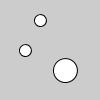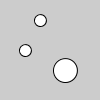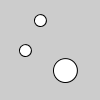| Name | add() |
||||||||||||||
|---|---|---|---|---|---|---|---|---|---|---|---|---|---|---|---|
| Examples |

v1 = PVector(40, 20, 0) v2 = PVector(25, 50, 0) ellipse(v1.x, v1.y, 12, 12) ellipse(v2.x, v2.y, 12, 12) v2.add(v1) ellipse(v2.x, v2.y, 24, 24) 
v = PVector(40, 20, 0) ellipse(v.x, v.y, 12, 12) ellipse(25, 50, 12, 12) v.add(25, 50, 0) ellipse(v.x, v.y, 24, 24) 
v1 = PVector(40, 20, 0) v2 = PVector(25, 50, 0) ellipse(v1.x, v1.y, 12, 12) ellipse(v2.x, v2.y, 12, 12) v3 = PVector.add(v1, v2) ellipse(v3.x, v3.y, 24, 24) | ||||||||||||||
| Description | Adds x, y, and z components to a vector, adds one vector to another, or adds two independent vectors together. The version of the method that adds two vectors together is a static method and returns a PVector, the others have no return value -- they act directly on the vector. See the examples for more context. | ||||||||||||||
| Syntax | .add(v) .add(x, y, z) .add(v1, v2) .add(v1, v2, target) | ||||||||||||||
| Parameters |
|
Updated on Tue Feb 27 14:07:12 2024.
If you see any errors or have comments, please let us know.

This work is licensed under a Creative Commons Attribution-NonCommercial-ShareAlike 4.0 International License